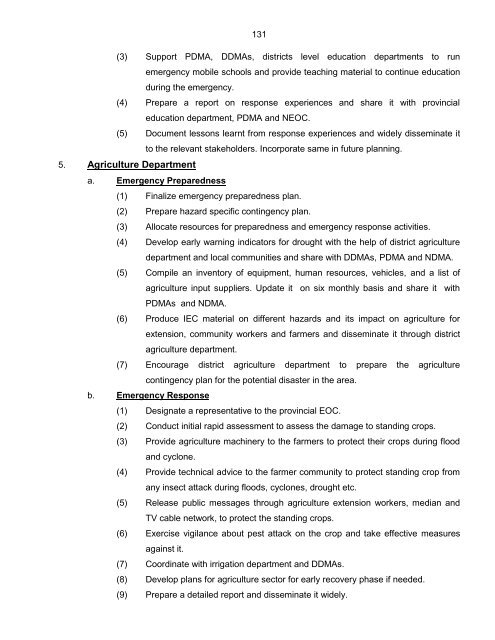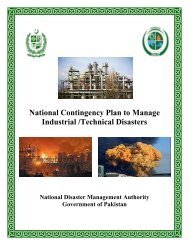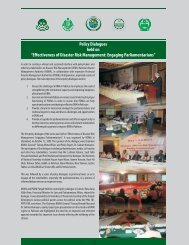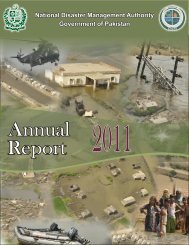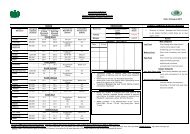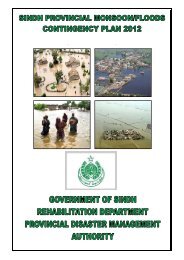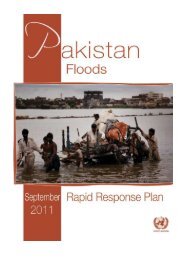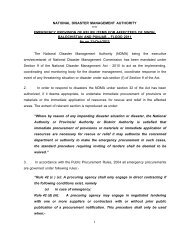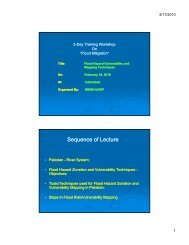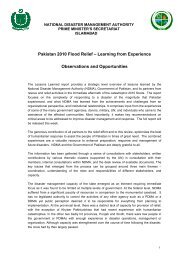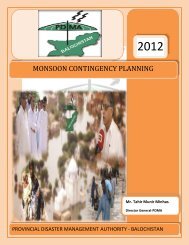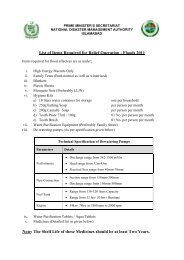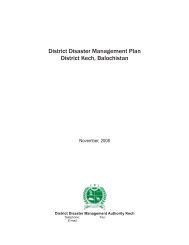National Disaster Response Plan (NDRP) March 2010 - NDMA
National Disaster Response Plan (NDRP) March 2010 - NDMA
National Disaster Response Plan (NDRP) March 2010 - NDMA
You also want an ePaper? Increase the reach of your titles
YUMPU automatically turns print PDFs into web optimized ePapers that Google loves.
131<br />
(3) Support PDMA, DDMAs, districts level education departments to run<br />
emergency mobile schools and provide teaching material to continue education<br />
during the emergency.<br />
(4) Prepare a report on response experiences and share it with provincial<br />
education department, PDMA and NEOC.<br />
(5) Document lessons learnt from response experiences and widely disseminate it<br />
5. Agriculture Department<br />
to the relevant stakeholders. Incorporate same in future planning.<br />
a. Emergency Preparedness<br />
(1) Finalize emergency preparedness plan.<br />
(2) Prepare hazard specific contingency plan.<br />
(3) Allocate resources for preparedness and emergency response activities.<br />
(4) Develop early warning indicators for drought with the help of district agriculture<br />
department and local communities and share with DDMAs, PDMA and <strong>NDMA</strong>.<br />
(5) Compile an inventory of equipment, human resources, vehicles, and a list of<br />
agriculture input suppliers. Update it on six monthly basis and share it with<br />
PDMAs and <strong>NDMA</strong>.<br />
(6) Produce IEC material on different hazards and its impact on agriculture for<br />
extension, community workers and farmers and disseminate it through district<br />
agriculture department.<br />
(7) Encourage district agriculture department to prepare the agriculture<br />
contingency plan for the potential disaster in the area.<br />
b. Emergency <strong>Response</strong><br />
(1) Designate a representative to the provincial EOC.<br />
(2) Conduct initial rapid assessment to assess the damage to standing crops.<br />
(3) Provide agriculture machinery to the farmers to protect their crops during flood<br />
and cyclone.<br />
(4) Provide technical advice to the farmer community to protect standing crop from<br />
any insect attack during floods, cyclones, drought etc.<br />
(5) Release public messages through agriculture extension workers, median and<br />
TV cable network, to protect the standing crops.<br />
(6) Exercise vigilance about pest attack on the crop and take effective measures<br />
against it.<br />
(7) Coordinate with irrigation department and DDMAs.<br />
(8) Develop plans for agriculture sector for early recovery phase if needed.<br />
(9) Prepare a detailed report and disseminate it widely.


